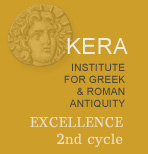Settlement E of Boubon
72. Dedication of a statue to the god Ares
![]()
5 10 |
ἀγαθῇ τύχῃ Αὐρήλιοι Τρωΐλος Θόαν– τος τρὶς τοῦ Ὀρέστου καὶ Κλέαρχος Μολέσεος Καλ– λικλέους καὶ Ἀρτέ<μ>ων Ἑρ– μαίου Ἀρτέμωνος Πρωτέου καὶ Κενδήβης Κλεάρχου Δη– μητρίου Βουβωνεῖ<ς> ἀ<γ>ορα– νομήσαντες τῇ πατρίδι κατεσκεύασαν τὸν ἀ<ν>– δρίαντα μετὰ τῆς βάσεως μεγίστῳ θεῷ Ἄρει καθὼς ὑπέσχοντο. |
To good fortune. Aurelii Troilos, son of Thoas III, son of Orestes, and Klearchos, son of Molesis, grandson of Kallikles, and Artemon, son of Hermaios, grandson of Artemon, great-grandson of Proteas, and Kendebes, son of Klearchos, grandson of Demetrios, citizens of Boubon, having exercised the office of market inspector for their city, set up the statue and the base for the greatest god Ares, as they promised.
Rectangular, profiled statue base found near no. 71.
Height: 161 cm (Schindler; now broken, measures 133 cm); length: 56 cm; depth: 67 cm; letters: 3-3.5 cm.
Schindler 1972, no. 4 (pl. 2.7); BullÉp 1973, no. 452; BCH 107 (1983), no. 579; Milner 1998, p. 3, no. 2.1; SEG 48 (1998), no. 1568; EBGR (1998) [2001], no. 187.
The upper part of this base was still intact in 1966 when Bean and Schindler discovered the stone, but it has now been knocked off, apparently recently, and the stone has also suffered some damage to its right side; the ends of lines 2-6 have been lost. The readings are nevertheless secured through a good photograph provided in Schindler, op. cit., pl. 2.7. The foot of the base is not preserved. There is a broken lower part of a base originally set in, or next to, the wall nearby (see no. 71), but it seems unlikely that that stone was part of the inscribed base no. 72, because in that case the entire base would have been more than three meters in height.
L. 2. Αὐρήλιοι : all four dedicants had received Roman citizenship under the Antoninian Constitution, therefore this inscription is likely to date to the third century CE. For the Constitution's effect in the provinces, see Buraselis 2007, particularly pp. 94-120.
L. 2-3 : Θόας: see also nos. 33 and 40. In mythology, Θόας was the son of the god Dionysos and Ariadne, the daughter of the king of Crete Minos. Thoas was himself king of the island of Lemnos. The name is popular in the Cibyratis, though the myth seems to have had no connection to this region. It may perhaps be a hellenized form of the native name Toues; Zgusta 1964, no. 1585.4; Milner 1991, p. 28. Schindler (op. cit., p. 47), suggests that the popularity of Thoas as a personal name in the Cibyratis must be due to the diffusion of the cult of the hero and its connection to Dionysos. The city of Oinoanda, argues Schindler, would have refered its name to wine (οἶνος), and thus favored Dionysiac cults. Though the cult of Dionysos is attested in the region, that of Thoas is not. Moreover, the name is equally popular in Pisidia (BullÉp 1973, no. 461). If anything, its diffusion in the region must be a consequence of movements of population and of close connections between the Cibyratis and its Pisidian neighbors. Ὀρέστης: cf. no. 23.
L. 4-5 : The name Κλέαρχος is found almost everywhere in the Greek world. It is attested a few times in Lycia: TAM II 15; 17; 717 (?); Bean 1971, no. 1; Petersen and Luschan 1889, p. 159, no. 187; Freyer-Schauenburg 1994, 11 A 3-4; Wörrle and Wurster 1997, p. 442 (Dereköy, attested four times). In Boubon cf. nos. 31 and 58. Μόλεσις: cf. nos. 27, 31, 23, 63, 39, 37, 26. It is an epichoric name, common in Lycia and Pisidia; cf. Zgusta 1964 no. 946.7; Milner and Eilers 2006, p. 68; Καλλικλῆς (cf. nos. 47, 39, 58, 67, 74) is a Greek name that is very frequent both in the Kibyratis and in Pisidia, in the area around Lake Burdur (Milner, op. cit.; cf. Schindler, op. cit. p. 49). It is attested 25 times in IK Kibyra I.
Ἀρτέμων: the stone has Ἀρτένων, but this is undoubtedly a stone cutter's error. Cf. no. 5 (l. 26).
L. 5-6 : Ἑρμαῖος: see no. 71. Πρωτέας: after the sea-god who had the ability to change his shape at will. The name is common in Caria but not in Lycia or the Cibyratis.
L. 7 : Κενδήβης "belongs to a class of epichoric (Pisidian) Kend- names which occur in Cilicia, Pamphylia and Lycia but are concentrated in and around Termessos" (Milner); cf. Zgusta 1964, no. 576. This Κανδήβης Κλεάρχου may be the son of a Κλέαρχος Κανδήβου attested in Dereköy (Wörrle and Wurster 1997, col. B II 42, cf. p. 442).
L. 8 : The stone has ΒΟΥΒΩΝΕΙΧ. Schindler notes only the stonemason's error immediately following this one: ΑΡΟΡΑ for ἀγορα(|νομήσαντες).
L. 10-12 : Chaniotis, EBGR (1998) [2001], no. 187, notes that the statue (ἀνδριάς) did not necessarily serve as a cult statue, and it may, in fact, not have been a statue of Ares at all. Cf. BullÉp 1973, 452, p. 172.

